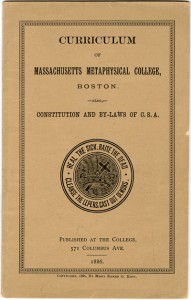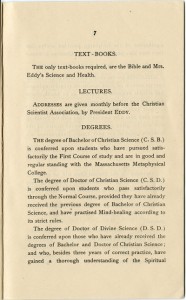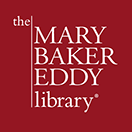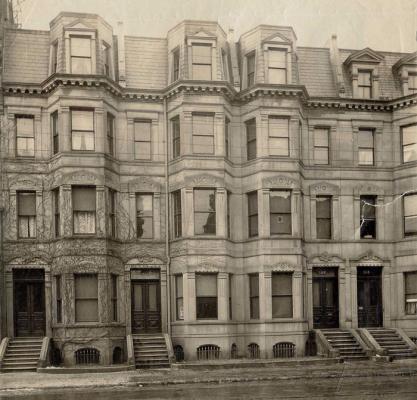569–571 Columbus Avenue. (P05362)
The Massachusetts Metaphysical College was chartered in 1881. According to the articles of agreement the College was “to teach pathology, ontology, therapeutics, moral science, metaphysics, and their application to the treatment of disease.” Mary Baker Eddy served as president and was the principal teacher. Some of the other classes were taught by people whom Eddy referred to as her “assistant teachers”; Asa G. Eddy (her husband), Dr. E. J. Foster Eddy (her adopted son) and her pupil General Erastus N. Bates. The College served an important role in the growth of the Christian Science movement in the United States during the nineteenth century, attracting students from the United States, Great Britain and Canada. These students generally returned to their homes to practice what Mary Baker Eddy had taught them.
As a chartered college it was necessary to have a student handbook, and this need was met by the production of the “Curriculum of Massachusetts Metaphysical College, Boston.” This pamphlet was a multi-purpose document — outlining the course of study, what was expected of students, tuition fees, and the degrees awarded by the College. The pamphlet also included the “Constitution and By-laws of Christian Scientist Association,” the association of Eddy’s students. The Curriculum was first published in 1884 by John Wilson and Son, Cambridge, Massachusetts, and a revised version was published in 1886 by the Massachusetts Metaphysical College. The Library has copies of both versions and they provide an interesting snapshot into the beginnings of organized Christian Science education.
 The purpose of the Massachusetts Metaphysical College is boldly outlined at the beginning of the pamphlet: “It meets the demand of the age for something higher than physics, physical hygiene, or drugging, to restore to the race hope, health, and the lost Science of Divine Healing.”1 At a meeting of the Board of the Metaphysical College in 1889 when the resolution to dissolve the College was passed, the minutes recorded the fact that the College had “fulfilled its high and noble destiny.” 2 3 According to the pamphlet the College enrolled “both male and female students” and did not deny admission to individuals “on account of their secular or religious opinions.” However, candidates for admission had to “evince a readiness to become humble and intelligent advocates of the teachings of Christ Jesus.”
The purpose of the Massachusetts Metaphysical College is boldly outlined at the beginning of the pamphlet: “It meets the demand of the age for something higher than physics, physical hygiene, or drugging, to restore to the race hope, health, and the lost Science of Divine Healing.”1 At a meeting of the Board of the Metaphysical College in 1889 when the resolution to dissolve the College was passed, the minutes recorded the fact that the College had “fulfilled its high and noble destiny.” 2 3 According to the pamphlet the College enrolled “both male and female students” and did not deny admission to individuals “on account of their secular or religious opinions.” However, candidates for admission had to “evince a readiness to become humble and intelligent advocates of the teachings of Christ Jesus.”
 The curriculum in 1886 included four courses; “The Principle and Practice of Christian Science or Mind Healing, Mental and Physical Obstetrics, Normal Course, and Scientific Theology.” Tuition for the four courses was $300.00, $100.00, $200.00 and $200.00 respectively. (It’s not clear if the “Scientific Theology” class was ever taught). The College did offer “Aid to Indigent Students,” though students had to prove their “need of pecuniary assistance” in order to receive a reduction in the cost of tuition. Eddy frequently gave discounts to students and even allowed some to attend free of charge. Based on which components had been completed satisfactorily, students would be awarded the following degrees; Bachelor of Christian Science (C.S.B.) and Doctor of Christian Science (C.S.D.). Interestingly, in the 1884 pamphlet the corresponding degrees are listed as; Christian Scientist (C.S.) and Doctor of Christian Science (D.C.S.).
The curriculum in 1886 included four courses; “The Principle and Practice of Christian Science or Mind Healing, Mental and Physical Obstetrics, Normal Course, and Scientific Theology.” Tuition for the four courses was $300.00, $100.00, $200.00 and $200.00 respectively. (It’s not clear if the “Scientific Theology” class was ever taught). The College did offer “Aid to Indigent Students,” though students had to prove their “need of pecuniary assistance” in order to receive a reduction in the cost of tuition. Eddy frequently gave discounts to students and even allowed some to attend free of charge. Based on which components had been completed satisfactorily, students would be awarded the following degrees; Bachelor of Christian Science (C.S.B.) and Doctor of Christian Science (C.S.D.). Interestingly, in the 1884 pamphlet the corresponding degrees are listed as; Christian Scientist (C.S.) and Doctor of Christian Science (D.C.S.).
On a lighter note the pamphlet also describes the South End neighborhood of Boston, where the College was located at 569-571 Columbus Avenue (from 1882-1889) as being “a quiet and beautiful portion of the city. Horse-cars pass the door every three minutes, running to the depots, and connecting with all parts of the city.” How times change!
- Curriculum of Massachusetts Metaphysical College (Boston: Massachusetts Metaphysical College, 1886), 5.
- Massachusetts Metaphysical College, EOR21, page 36, Early Organizational Records.
- Eddy reopened the College in 1899 “as auxiliary to her church,” under the auspices of the Board of Education of The First Church of Christ, Scientist. Eddy, Science and Health with Key to the Scriptures (Boston: The Christian Science Board of Directors) xii; Eddy to William B. Johnson, 24 February 1898, L00714.


